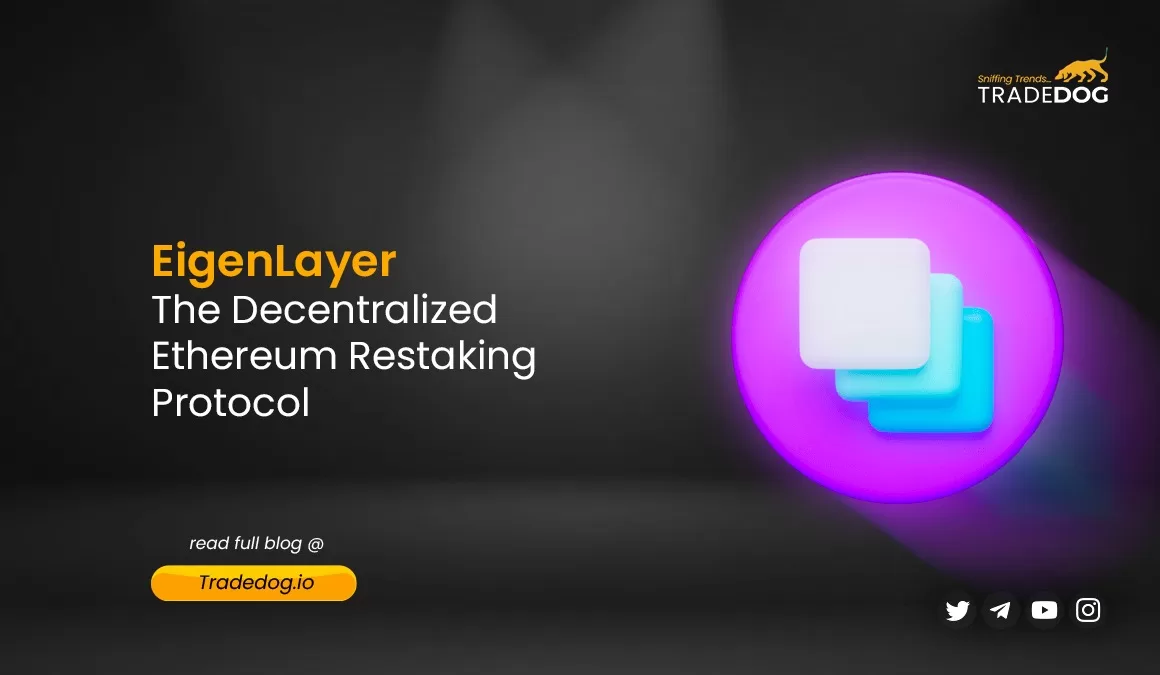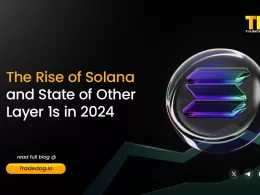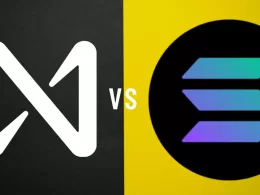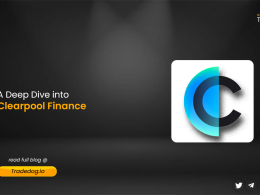Quick Links
EigenLayer is a revolutionary protocol designed to enhance the capabilities of Ethereum’s Layer 2. Its vision is to create a more dynamic, diverse, and secure ecosystem for dApps and protocols, thereby driving increased user adoption and engagement. EigenLayer’s AuM has impressively surged from ~$1.09 billion to $3.91 billion, which is ~257% within a week. Moreover, the TVL has surged ~190% from ~$2.1 billion to ~$6.1 billion.
What is EigenLayer?
The journey of EigenLayer began with the launch of Stage 1 in June. This significant milestone introduced the concept of restaking on mainnet Ethereum. Restaking is a unique feature that allows Ethereum stakers to secure multiple services simultaneously by restaking their staked ETH. This creates a pooled security model, a key component of EigenLayer’s vision to create a faster-growing and more dynamic Ethereum ecosystem.
It is built on the Ethereum network and is the brainchild of Sreeram Kannan. It was launched in June 2023 to extend the mainnet’s security and trust to other apps and services without needing a new set of validators. This protocol has created a unified interface for standard stakeholders to commit security to a broader range of protocols. As a result, EigenLayer has opened up new use cases for the Ethereum network, including data availability for layer-2 rollup solutions, enhanced cross-chain transactions, decentralized sequencers ensuring efficient transaction ordering, and Miner Extractable Value (MEV) managing solutions.
How EigenLayer Works?
EigenLayer’s operation varies depending on the type of restaker. Those holding liquid staking tokens (LSTs) deposit their LSTs into a smart contract. However, for native restakers (those holding ETH and staking directly on Ethereum), an EigenPod must be created, and the restaker’s withdrawal credentials must be pointed at the EigenPod’s address. To begin restaking, ETH holders must stake their ETH on Ethereum using their chosen method, ensuring to use the EigenPod address for withdrawal credentials. It is important to note that EigenLayer was not designed to receive execution layer (EL) rewards.
There is a delay between staking on Ethereum and being permitted to restake on EigenLayer for native restakers. This delay allows EigenLayer time to verify the stake through their oracle. Once the stake on Ethereum is confirmed, restakers can delegate to operators on EigenLayer, who run programs on behalf of AVSs. Until a deleation from the restaker to an operator has been made, the position looks very similar to regular staking on Ethereum. The difference is that consensus layer rewards and stakes go through the EigenPod before being sent to the restaker’s address upon withdrawal. For consensus layer rewards that are occasionally swept to the EigenPod, restakers can withdraw, restake, or leave them in the EigenPod.
Benefits of EigenLayer
- Efficient Staking: EigenLayer enhances staking efficiency by allowing staked ETH to secure more than just Ethereum, providing an opportunity for stakers to earn additional rewards.
- Trust Network for Builders: It enables builders to secure their infrastructure without creating validator sets, setting up complex consensus mechanisms, or launching native tokens.
- Shared Security: EigenLayer’s shared security model attracts more developers to build on Ethereum, fostering a dynamic and diverse ecosystem of dApps and protocols.
- Decentralized Growth: Using Ethereum as the source of crypto-economic trust, EigenLayer drives decentralized growth and increases user adoption and engagement.
- Improved Capital Efficiency: EigenLayer optimizes capital use by enabling staked ETH to secure other protocols. This opens up avenues for stakers to utilize their staked ETH more effectively.
- Higher Rewards: With EigenLayer, stakers can earn more rewards. This is possible through the restaking of ETH, which brings additional benefits.
- Access to New Protocols: EigenLayer provides access to novel AVS and DApps. This not only broadens the scope of available applications but also aids in reducing Ethereum gas fees.
Growth and Development
The growth of EigenLayer since its launch has been nothing short of remarkable. At the time of launch, the Assets Under Management (AUM) was approximately $19 million, divided among rETH, cbETH, and stETH.
Fast forward to February 2024, the AUM has skyrocketed to around $3.91 billion. This substantial increase is distributed among various Liquid Staking Tokens (LSTs) as follows:
- ETHX: ~$275.39 million
- ankrETH: ~$3.90 million
- wBETH: $221.30 million
- oETH: ~$52.80 million
- swETH: ~$544.93 million
- osETH: ~$47.26 million
- rETH: ~$181.11 million
- cbETH: ~$87.05 million
- stETH: ~$2.50 billion
The number of depositors has also grown significantly, with a total of 108,966 depositors now participating in the EigenLayer protocol. The number of supported LSTs has increased to 9, further diversifying the options available to users.
EigenLayer’s growth is also reflected in the participation of its depositors in previous airdrops. Here are the top 10 projects by depositor participation:
| Project | # of Depositors | Participation Rate |
|---|---|---|
| Arbitrum | 35,749 | 32.79% |
| Optimism | 11,672 | 10.71% |
| Blur | 7,444 | 6.83% |
| Arkham | 4,838 | 4.44% |
| LooksRare | 4,054 | 3.72% |
| Hop Protocol | 3,903 | 3.58% |
| DappRadar | 3,876 | 3.56% |
| Uniswap | 3,350 | 3.07% |
| Gas DAO | 3,346 | 3.07% |
| Ethereum Name Service | 3,059 | 2.81% |
Catalysts for Growth
- Reopening of Deposits: Reopening deposits on the EigenLayer platform has been a significant factor in its growth. This action has allowed more users to participate in staking, increasing the total value locked (TVL) in the protocol.
- Removal of Staking Limits: The removal of staking limits has created a more conducive environment for users. With no upper limit on the amount that can be staked, users have been able to contribute more to the protocol, driving up the TVL.
- More Depositors: The rise in unique depositors to ~108K signifies growing trust in EigenLayer. As more people deposit their assets, the TVL of the platform increases, contributing to its growth.
- Market Dynamics: The competitive landscape of tokens in the market influences the growth of EigenLayer. As tokens like Lido’s stETH gain popularity and are restaked, the TVL of EigenLayer grows.
- No More Staking Limits: EigenLayer has allowed users to stake more assets by removing limits on staked value. This decision has led to an increase in the TVL, contributing to EigenLayer’s growth.
- Partnerships: Partnerships with leading entities in the decentralized finance space have expanded EigenLayer’s reach and influence. These collaborations have brought more users and assets to the platform, boosting its growth.
- Community Role: The active participation of the community in discussing and implementing measures has fostered a sense of ownership and engagement. This active involvement has led to more staking and restaking activities, driving the growth of EigenLayer.
- Funding and Expansion: Raising substantial funds and expanding staking capacity have given EigenLayer the resources to grow. With more funds, EigenLayer can support more staking activities, leading to an increase in its TVL.
Future Outlook for EigenLayer
EigenLayer is a new protocol on the Ethereum blockchain that has already made a significant impact. It has a unique “restaking” feature that has attracted many users. ~ 2.46m ETH has been staked in EigenLayer. This is a big deal because it shows users trust EigenLayer with their money. The more ETH that is staked, the more secure the network becomes.
EigenLayer has some exciting plans for the future. They are going to introduce new features called delegation and operator features. These features will let users delegate their staked assets to specific operators. This means users can have more control over their staking strategies. These new features are expected to make EigenLayer even more trustworthy and make it easier for people to get involved.
EigenLayer’s shared security model could also significantly impact the Ethereum ecosystem. This model allows developers to build on Ethereum without worrying about securing their infrastructure. This could attract more users, stakers, and builders to Ethereum. In conclusion, the future of EigenLayer looks bright. However, like any other protocol in the crypto space, monitoring the metrics and developments is essential to understand its progress and impact.
In conclusion, EigenLayer has shown remarkable growth since its launch. With its innovative approach to restaking, continuous expansion, and active community engagement, EigenLayer is well-positioned to revolutionize the Ethereum ecosystem. The protocol’s ability to solve the problem of trust network fragmentation and bootstrapping has opened up new possibilities for the Ethereum ecosystem.









